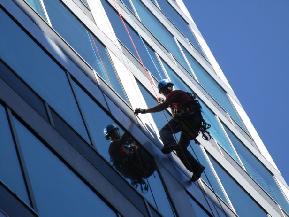Many of us take for granted that the air that we breathe every day is acceptable for human consumption. Phrases like “getting some air,” “clearing my lungs” or “taking a breather” have become synonymous with getting outside a building, whether it be your home or office. When you think about those phases, ask yourself, “Shouldn’t the air inside be as good as outside?” According to the US Environmental Protection Agency (USEPA), Americans, on average, spend approximately 90 percent of their time indoors. While we consistently consider what is in the water we drink and the food we eat, we rarely think about what could potentially be in the air that we breathe, particularly the air that is circulated in offices, stores, schools, or even our own homes.
For the past few decades, buildings have been designed for energy efficiency: they keep tempered air within the building to drive down energy costs and consumption. While energy efficiency is a good thing, tightly sealed facilities can trap hazards such as mold, toxins, and carbon dioxide within the space occupied by humans. In recent years, especially during the COVID pandemic, we have learned more about how insulated indoor atmospheres may create an environment that is detrimental to the health and productivity of humans. We generally assume that we are at a greater risk of breathing in harmful, airborne toxins (i.e., vehicle exhaust, chemical spills, etc.) while being outside, but one of the main roles of the USEPA is to monitor and continually create regulations to govern the quality of outdoor air. Who is keeping an eye on the quality of indoor air?
What is Indoor Air Quality (IAQ)?
Indoor Air Quality refers to the air that is inside a facility. However, the air surrounding a facility should also be considered, as most facilities draw some outdoor air into the HVAC system, creating the opportunity for pollutants to be unintentionally released inside. These may include microbial contaminants (like mold or bacteria); gases (like carbon monoxide, VOCs or radon); toxic chemicals (cleaners) or building materials (formaldehyde) and components (asbestos and lead). Routine inhalation of these pollutants can cause illnesses and a decrease in productivity for inhabitants. In extreme cases, this can lead to a phenomenon now referred to as sick building syndrome. It is essential to be proactive about indoor air quality to prevent health concerns and legal liabilities. A proactive approach helps to ensure that occupants do not become ill and any existing concerns do not increase in severity.
The American Society of Heating and Air-Conditioning Engineers (ASHRAE) has set standards for “acceptable indoor air quality,” but in this context, acceptable just means there isn’t a strong concentration of any known contaminants and that the majority (80%+) of people present do not complain about the current conditions. It doesn’t necessarily mean that the air quality is the best it could possibly be. Additional steps can be taken to ensure that the standards are increased to protect commercial real estate occupants against pollutants, contaminants, and infectious diseases such as influenza and COVID-19.
What Can You Do?
While it is an on-going process that cannot be solved overnight, Facility Owners and Property Managers can employ several immediate steps to improve the current air quality for their inhabitants. The first step in any improvement is engaging an industrial hygiene expert to determine which issues need to be remedied. This can be done through testing and sampling during a comprehensive assessment. A routine assessment should include field measurements of temperature, relative humidity, carbon dioxide, carbon monoxide, and organic compounds, using hand-held meters (e.g., IAQ meter, multi-gas meter, photo-ionization detector (PID), etc.).
When water intrusion is suspected, a moisture survey should be conducted using appropriate instrumentation. If indoor air sampling for mold is performed, then appropriate samples should also be collected outdoors for comparison-to-baseline purposes. Additional chemical and/or biological sampling and analysis may be performed if warranted, by observing site conditions, and/or if exposure to specific chemical contaminants is suspected. Justification for additional chemical and/or biological sampling and analyses should be provided.
After determining the elements that are impacting the indoor air quality, there are changes that can be made immediately. In the event of water intrusion, building envelopes can be checked for leaks, plumbing systems can be inspected for faults, and HVAC systems can be evaluated for optimal performance. Industrial hygiene and remediation experts can safely disinfect and remove any materials contaminated by water intrusion (like mold) or undisclosed materials (like asbestos). The implementation of filtration systems and increased ventilation can provide relief to inhabitants and increase the overall quality of your indoor air. The best long-term solution is creating an indoor air quality plan that includes regular testing, system inspections, maintenance, and/or upgrades.

















 Copyright © 2024 ALM Global, LLC. All Rights Reserved.
Copyright © 2024 ALM Global, LLC. All Rights Reserved.